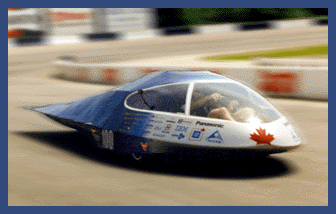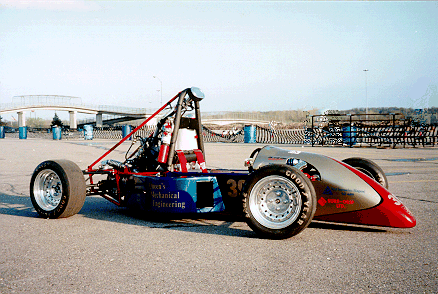Solar Car
The Queen's University Solar Vehicle Team began in 1988 with an entry in Canada's first
solar car event, the Great Canadian Solar Race, around the ring road at The University of
Waterloo. Queen's won this race with Photomoto, a small car that had a
top speed of only 40 km/h.
Since that time, Queen's has built four more solar cars and has competed both in North
America and Australia. In 1990 Sunquest became the first Canadian solar car to finish
the 3000+ km World Solar Challenge across the Australian outback.
Our fourth car, Quest, placed sixth at Sunrayce '95. With a top speed
of over 105 km/h, Quest is the most successful Canadian car in international competition.
Queen's 5th and current car, Dawn Treader,
is capable of obtaining speeds of over 120 km/h making it our most advanced car to date.
Competing in the World Solar challenge 1996, Dawn Treader achieved the top North American
placing and best Canadian showing ever at this event. It most recently participated in Sunrayce '97, a ten-day staged race from Indianapolis to
Colorado Springs, competing against 36 other cars from colleges and universities across
North America.
The EngSoc Web hosts an impressive site filled with current information about the Solar
Car. It's not on the Legend of the Greasepole CD, but if
you have an active Internet connection you can click
here to visit it.
Queen's Formula SAE
Queen's Formula SAE team is composed of dedicated engineering students
working together to design and build a formula-style race car. The team is
multi-disciplinary, stressing both mechanical and electrical engineering skills. Team
members are of all years: encouraging participation from all years ensures a smooth
transition from year to year, building experience. Each member contributes in their field
of interest and reaps the benefits of experience and team work while working in an
environment of enthusiasm and learning.
The Formula SAE Competition was developed as an opportunity for engineering students to
conceive, design, fabricate, and compete small formula-style cars.
Competition restrictions limit frame and engine dimensions to challenge the knowledge,
creativity, and imagination of the students involved. Our team entry is judged annually in
May against approximately 80 other entries from participating schools throughout North and
South America.
Queen's Formula was established in 1993 and had a very successful first showing,
placing in the top half of the field at the 1994 Formula SAE competition. The 1995
competition saw the team improve their standing as they finished with a top twenty
position in a field of over 80 competitors from across the continent. The success of the
team in the first two years of the competition has inspired this year's team to strive for
a higher standing!
This project provides an invaluable opportunity to apply the high standard of
theoretical knowledge that is attained at Queen's in a real-life, competitive scenario.
Skills such as project management, documentation, cooperation, and time organization are
emphasized. The team currently consists of members from Mechanical, Electrical, and
Materials Engineering and supports and provides a testing ground for thesis students.
Graduates learning these skills will leave Queen's with abilities that will be beneficial
to future employers.
The EngSoc Web hosts an impressive site filled with current information about the
Formula SAE Team. It's not on the Legend of the Greasepole CD,
but if you have an active Internet connection you can click here to visit it.
Queen's Engineering Competition
This ain't no ordinary science fair! This is the annual battle of the Queen's
Engineering Gladiators! Every discipline and interested fourth year students enter a
project in the Queen's Engineering Competition held early in the New Year. Winners
continue onto Ontario and Canada wide competitions.
Previous project entries have included a voice controlled wheelchair (electrical
engineering) and an advanced bicycle lock (mechanical engineering). The bike lock went on
to win the Entrepreneurial Design Category of the Canadian Engineering Competition.
Besides allowing students to compete with their engineering projects, QEC also provides an
excellent opportunity for frosh to talk to upper years about the interesting aspects of
various disciplines.
QEC now offers 3 different types of competitions, so Queen's engineering students of
all years can compete.
1. Design Competition: Here is your chance to show off that pet
project you have been working on in your Top Secret Laboratory. The Design Competition
requires engineering savoury and original, creative design work. Thesis projects and
Experience Option work term (or summer job) projects (with permission of employer) are
also eligible for entry. You may work alone or in teams. If you are looking for a
project idea consider talking to Faculty members in your engineering discipline. Most
Queen's engineering disciplines are very supportive of QEC and will be eager to offer
technical (and occasionally financial) assistance for projects.
2. Explanatory Communications: Do you get off talking about
nuclear magnetic resonance? Do you think you can explain the wonders of fluid dynamics to
the unwashed masses? Then explanatory communications is for you! This is an oral
competition that requires you to discuss and explain your favourite technical engineering
subject in "layman" terms. Each competitor will be limited to 20 minutes. The
more technical the subject, the better.
3. Quickie Design: If you ever played with Lego, you are going to love
the new Quickie Design competition. Competing in teams (maximum of four people per team),
you will be given two engineering problems two weeks in advance of the competition. The
most ingenius solutions will take home the trophy.
Aero Design Team
As the University's Aero Design Team, our goal is to build a
remote-controlled plane that will compete in this year’s Aero Design East
competition. The competition has been organized by the S.A.E (Society of Automotive
Engineers) for the past six years, and is attended by dozens of teams from universities
across the continent. Our team performed quite well in the past and we’re hoping to
do even better this year, with more team members than ever and the help of our generous
sponsor, Fleet Industries.
Mini Baja Team
For the past few years, dedicated teams of mechanical engineering students have
competed in the Society of Automotive Engineering Eastern Mini Baja Competition.
The aim of the competition, attended by top engineering universities from across North
America, is to design and build an all-terrain, fully amphibious vehicle. This year, 13
engineering students in their third or fourth year are once again undertaking the
challenge of creating a faster, more versatile, and durable machine - from scratch. For
motivation, they need look no further than the excellent results last year's team
achieved. In the university contest held last May in Orlando, Florida, Queen's entry,
Thundermug II placed 16th in a field of 48 entries. They beat such Ivy League names as
Princeton and from home McGill. Last year's car was decked out with steel tubing frame,
foam-covered Kevlar fibreglass, a snowmobile clutch and as a special feature, a formula
One racing seat. The Queen's Baja team's committment begins in September, eight months
before the actual competition takes place. One of the biggest advantages of the project is
the chance for real engineering. The students must manage their time, find their own
funding and sponsors, and aside from the engine supplied by the competition organizers,
produce a functional vehicle. Students who participated in last year's project estimated
the time commitment to range anywhere from eight to twenty hours a week, per student.
In 1993, Mechanical Engineering Department made the project part of a fourth-year
elective, called Market-Oriented Design. In the past, the vehicle has
part of many student's thesis fourth-year thesis project. However, the main incentive is
the chance for students to gain hands-on practical skills. Students stress the importance
of "getting people acquainted with manufacturing methods" and "developing
manufacturing ability." The experience is meant to give students an advantage in the
job market.
|